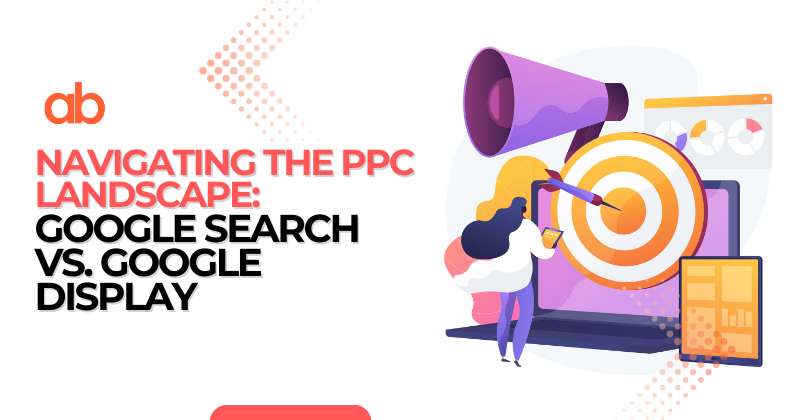Let’s dive into the dynamic worlds of Google Search and Google Display, unraveling their unique features, strategies, and how to seamlessly integrate them for a potent PPC campaign. Fasten your seatbelts as we explore the art of strategic advertising on Google!
1. Google Search vs. Google Display: A Strategic Overview
When to Use Each Tactic?
Google Search:
- Use When: Intent is high, and users actively search for specific products or services.
- Ideal for: Direct response campaigns, selling products or services, capturing high-intent leads.
Example: A shoe retailer may use Google Search to target users actively searching for terms like “running shoes,” aiming for immediate conversions.
Google Display:
- Use When: Building brand awareness, reaching a broader audience, visual storytelling.
- Ideal for: Displaying visual ads, promoting brand visibility, targeting users across the web.
Example: An apparel brand might use Google Display to showcase visually appealing ads featuring its latest collection, targeting users interested in fashion across various websites.
2. What’s the Goal of Each Tactic?
Google Search:
- Goal: Direct response – driving clicks and conversions from users actively searching for relevant keywords.
- Focus: Delivering immediate and specific solutions to user queries.
Example: A travel agency running Google Search ads aims to lead users searching for “best vacation deals” directly to a page where they can book their trips.
Google Display:
- Goal: Building brand awareness and engaging a broader audience.
- Focus: Capturing attention through visually appealing ads, telling a brand story, and fostering recognition.
Example: An electronics brand might use Google Display to showcase an ad featuring its innovative products, targeting a wider audience interested in technology.
3. How to Use Each Tactic?
Google Search:
- Keywords: Focus on relevant keywords with high commercial intent.
- Ad Copy: Craft concise and compelling ad copy directly addressing user queries.
- Landing Pages: Optimize landing pages for a seamless user experience post-click.
Example: For an online pet store, a Google Search ad targeting the keyword “organic dog food” should lead users to a landing page specifically showcasing and offering organic dog food products.
Google Display:
- Visual Creatives: Invest in visually striking images or interactive creatives.
- Targeting: Utilize demographic, interest, and contextual targeting to reach specific audience segments.
- Ad Placement: Select strategic ad placements on websites your target audience frequents.
Example: A fitness brand could use visually appealing images of its new workout gear in a Google Display ad. Targeting could include fitness enthusiasts and placing ads on health and lifestyle websites.
4. How to Combine Both Tactics?
- RSLA (Remarketing Lists for Search Ads): Use audience data from Google Display campaigns to refine and target Google Search ads to users who have previously engaged with your brand.
- Cross-Channel Messaging: Ensure consistent messaging across both Search and Display to reinforce brand identity and user recall.
Example: If a user interacted with a Google Display ad for a clothing brand’s summer collection, the subsequent Google Search ads could align with the same theme and offer related products.
5. How to Determine the Budget of Each Tactic?
- Google Search: Allocate budget based on the competitiveness of keywords and desired click volume.
- Google Display: Set a budget considering the reach and impressions you aim to achieve. CPM (Cost Per Mille) and CPC (Cost Per Click) bidding options are available.
Example: A retail brand might allocate a larger budget to Google Search during peak shopping seasons when competition for keywords is high. For Google Display, they may allocate a budget focused on reaching a broad audience during brand awareness campaigns.
6. Best Practices
Unified Branding: Maintain consistent branding elements across both Search and Display ads to reinforce brand identity.
Example: Use the same color scheme, logo, and messaging in both Google Search and Display ads to create a cohesive brand experience.
Segmented Campaigns: Create specific campaigns for Search and Display to have more control over targeting, bidding, and ad creatives.
Example: Segregate campaigns for different products or services, allowing for more precise control over budget allocation and targeting parameters.
Utilize Ad Extensions: Leverage ad extensions in Google Search to provide additional information and enhance ad visibility.
Example: A local business could use location extensions in Google Search ads to display the physical address, making it easier for users to find their storefront.
7. Common Mistakes
Overlooking Audience Targeting: Neglecting precise audience targeting on Google Display can result in ads being shown to an irrelevant audience.
Example: An ad for luxury watches might not resonate with a broader audience if displayed on websites unrelated to fashion or lifestyle.
Ignoring Negative Keywords: Failing to regularly update and refine negative keyword lists in Google Search can lead to irrelevant clicks and wasted budget.
Example: For a law firm bidding on the keyword “legal advice,” negative keywords like “free” or “DIY” could be added to avoid clicks from users seeking free legal resources.
Neglecting Ad Creative Quality: Low-quality ad creatives on Google Display can undermine your efforts. Invest time and resources in visually appealing and engaging creatives.
Example: An ad for a travel destination should feature high-quality images showcasing the beauty of the location to captivate the audience’s attention.
Google Search and Google Display offer distinct yet complementary opportunities in the PPC landscape. By strategically deploying each tactic based on campaign goals, understanding your audience, and avoiding common pitfalls, you can orchestrate a harmonious PPC symphony that maximizes your brand’s reach and impact. Happy advertising!



